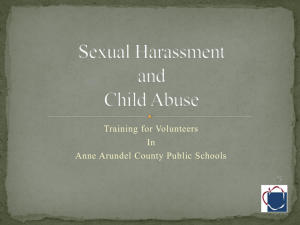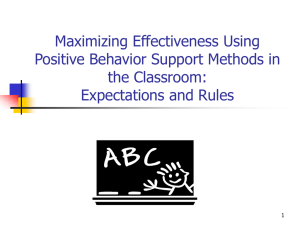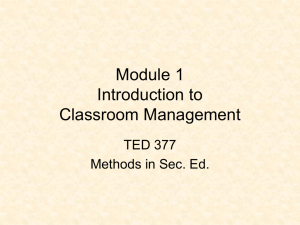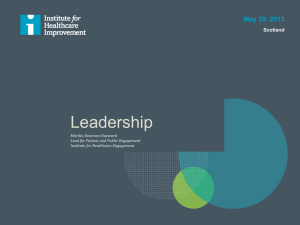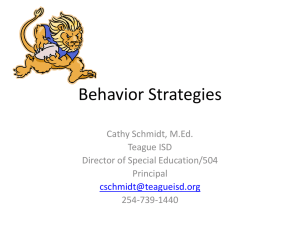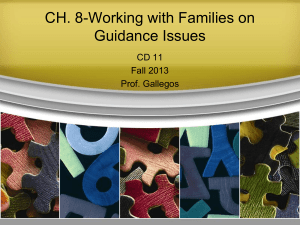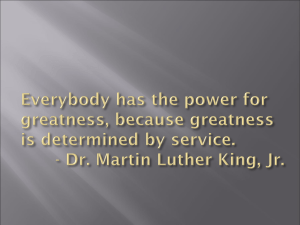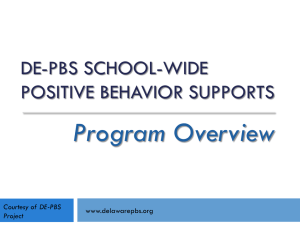Correcting Problem Behaviors
advertisement
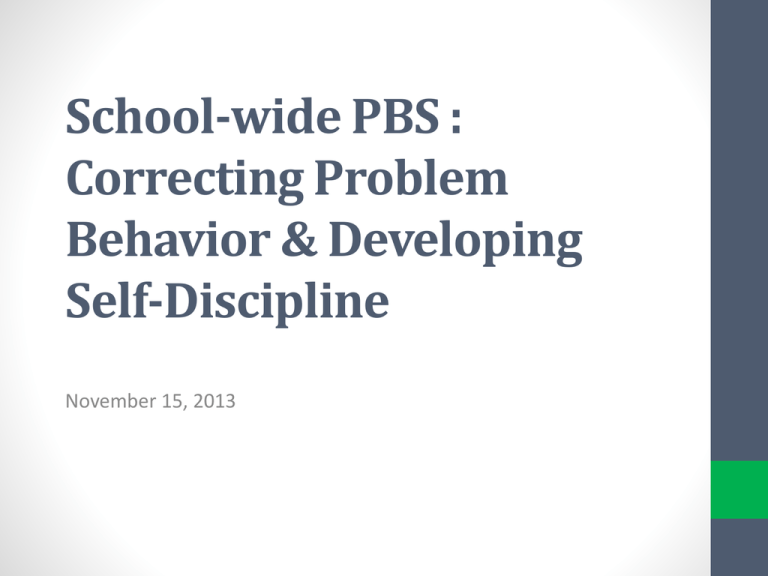
School-wide PBS : Correcting Problem Behavior & Developing Self-Discipline November 15, 2013 Success Sharing • At your table, think of strategies that have been successful this year. • Write strategies using a different piece of paper for each of these categories: • Data use and sharing • Teaching & Acknowledging Expectations • Buy-in for Students, Staff, Parents • Leadership Team Effectiveness • Include school name next to strategy. Solution Sharing • Hang strategies on wall under category heading; Note elementary vs. secondary areas. • Explore categories where you need additional ideas. • Debrief – Have participants ask for follow-up information on a strategy they are interested in knowing more about. DE-PBS Key Features for SW • Program Development & Evaluation • Problem-Solving/Leadership Team • Data • Professional Development & Resources • Developing SW and Classroom Systems to Prevent Problem Behavior • Expectations, Recognition and Teaching • Positive Relationships • Correcting Problem Behaviors • Consistent and clear procedures • Disciplinary encounters used as learning opportunities to teach problem solving strategies • Developing Self-Discipline Correcting Problem Behaviors Delaware Assessment of Strengths and Needs for Positive Behavior Supports (DASNPBS) • Staff perception survey designed to gain insight & input of school staff in DE-PBS implementation and planning • Aligned to Delaware’s Key Features of Positive Behavior Support • 4 sections, 10 items each • School-wide Tier 1 - Program Development and Evaluation • Implementing Schoolwide & Classroom Systems • Developing Self-Discipline • Correcting Behavior Problems DE-PBS Key Features for SW • Correcting Problem Behaviors • Referral system • ODR form is clear – defines specific behavior problem, location, time (WHY – think about big 5) • Data entered in school system w/in 24 hours – ideal goal • Consistent and clear procedures • Major vs. minor • Defining behaviors • Disciplinary encounters used as learning opportunities to teach problem solving strategies • Staff response (minor) • Administrative response (major) Strategies to Support the Discipline Process • Consistent and judicious enforcement of rules • Awareness of rules and policies • Referral Form Components • Classroom vs. Office Managed • Defining Form Fields Referral System: Discipline Referral Form • Goal: Comprehensive yet easy to complete • Clarity on the referral form takes the guess work out of the data entry person’s job • Clear distinction between major (officemanaged) vs. minor (classroom-managed) problem behaviors • Consistent data entry procedure Ideal Referral Form Components • • • • • • Student Name Date Time of incident Grade Level Referring Staff Location • • • • Problem Behavior Possible Motivation Others Involved Administrative Decision • Other Remember to use checkboxes whenever possible and minimize writing which can be subjective. DE-PBS Key Features for SW • Correcting Problem Behaviors • Referral system • ODR form is clear – defines specific behavior problem, location, time (WHY – think about big 5) • Data entered in school system w/in 24 hours – ideal goal • Consistent and clear procedures • Major vs. minor • Defining behaviors • Disciplinary encounters used as learning opportunities to teach problem solving strategies • Administrative response (major) • Staff response (minor) Consistent & Clear Procedures: Classroom vs. Office Managed • Staff should know what problems are officemanaged and what problems are classroom– managed • This process must be defined, taught, and agreed upon with all staff, and must include definitions for: • major discipline incidents • minor discipline incidents • a continuum of discipline procedures Staff Managed Behaviors •Tardiness (on 3rd tardy, enter student into Response System) •Non-compliance with staff direction •Classroom disruption •Bullying •Inappropriate language •Failure to serve teacher assigned reflection •Unprepared for class •Leaving the classroom without permission •Skipping class •Inappropriate hallway behavior •Inappropriate computer use •Inappropriate locker behavior •Dress code violation •Throwing objects •Eating/drinking in class •Academic dishonesty •Sleeping in class •Carrying backpack •Electronic devices/cell phones (visible and/ or on) OFFICE MANAGED BEHAVIORS •Bomb Threat/False Alarm •Possession of a Weapon/Explosive Device •Threats of bringing/using Weapons •Fighting/Physical Aggression •Physical Assault/Harassment •Intimidation •Sexual Harassment/Sexual Offense •Loitering •Theft/Burglary •Verbal Abuse and/or Threat of Violence •Inappropriate Bus Behavior •Failure to Identify Oneself •Truancy •Vandalism/ Property Damage •False Fire Alarm or Arson •Possession/Distribution/Use of OTC Medication, Controlled Substance, Tobacco, or Alcohol •Leaving the Classroom without Permission •Forgery/Extortion Activity: Determining Major vs. Minor Behavior • Individually, brainstorm problem behaviors place them in a category. • Major • Minor • Need more Thought & Discussion • Compare lists with team members. How do you differ? Why do you differ? Are you on the same page? • Make plan to dialogue with fellow staff, problem-solve around behaviors for discussion, and develop a finalized list. Appropriate Definitions of Problem Behaviors • Develop a clear set of definitions for all categories on the office discipline referral form • Problem behaviors must be operationally defined • Once behaviors are defined, all faculty, staff, administration, students and families will need to be trained on the definitions • All problem behaviors are covered and none of the definitions overlap • Consistent definitions make data collection much more accurate and reliable Defining Behaviors – Minor Examples Minor Behaviors Definition Inappropriate verbal language Student engages in low intensity instance of inappropriate language Defiance/ disrespect/ noncompliance Student engages in brief or lowintensity failure to respond to adult requests Tardy Student arrives at class after the bell (or signal that class has started). Defining Behaviors – Major Examples Major Behaviors Definition Disruption Behavior causing an interruption in a class or activity. Disruption includes sustained loud talk, yelling, or screaming; noise with materials; horseplay or roughhousing; and/or sustained out-of-seat behavior. Harassment/Bullying Student delivers disrespectful messages (verbal or gestural) to another person that includes threats and intimidation, obscene gestures, pictures, or written notes. Disrespectful messages include negative comments based on race, religion, gender, age, and/or national origin; sustained or intense verbal attacks based on ethnic origin, disabilities or other personal matters. Activity: Webster Time • Make a group of 2-3 team members • Pick a problem behavior (subjective in nature) from your ODR form, or a behavior for discussion • Operationally define the problem behavior • When cued, pass the draft to another group at your table • Revise, or ask questions if something is not clear General Procedure for Dealing with Problem Behaviors Observe problem behavior No Find a place to talk with student(s) Yes Is the behavior major? Ensure safety Problem Solve Write referral & Escort student to office Determine consequence Problem solve Follow procedure documented Determine consequence Follow documented procedure Etc. Adapted from procedure 2.0 A. Todd U of Oregon Etc. Define Behavior Expectations Model Appropriate Behavior Use the following teacher consequences: (Must be documented prior to writing office referral for Teacher Managed Behaviors.) Parent contact is a MUST! 1st Offense: Observe Problem Behavior NO Decide: Is the behavior office managed? Teacher Managed Behaviors YES Office Managed Behaviors Student/Teacher Conference (Warning) 2nd Offense: Teacher determined consequence (i.e. lunch or after-school detention, seat change, loss of privilege) 3rd Offense: Teacher determined consequence+ Parent Contact •Language •Minor Insubordination •Lateness •Calling Out •Minor Throwing •Non-Performance or Refusing to Work •Preparedness •Minor Dishonesty •Disrespect •Disruption •Inappropriate Tone or Attitude •Dress Code Violation (send to the office) •Food or Drink •Gum •Running in the Halls/Horseplay 4th Offense: Office Referral Per Marking Period •Chronic Minor Infractions (x3) •Failure to Comply with Teacher Consequences •Cell Phone(confiscate) •Fighting or Aggressive Physical Contact •Profanity Towards Teacher •Major Insubordination •Weapons •Harassment •Bullying •Academic Dishonesty •Skipping Class •Drugs/Alcohol •Smoking •Vandalism •Theft • Threats •Gambling •PDA Write referral to the office Administrator Restates Behavior Expectation with Student + Administrator Issues Appropriate Consequence + Administrator Contacts Parents + Administrator Provides Teacher Feedback Activity: Response Procedures • Individually, draft your current response procedures based on your experience (e.g, as teacher, as administrator, etc.) • When cued, please share with other team/table mates to look for consistency & differing procedures/responses • Discuss steps for developing school-wide systems for response DE-PBS Key Features for SW • Correcting Problem Behaviors • Referral system • ODR form is clear – defines specific behavior problem, location, time (WHY – think about big 5) • Data entered in school system w/in 24 hours – ideal goal • Consistent and clear procedures • Major vs. minor • Defining behaviors • Disciplinary encounters used as learning opportunities to teach problem solving strategies • Administrative response (major) • Staff response (minor) Key Feature • Recognize the critical importance of correcting misbehavior using a combination of evidencebased techniques for increasing appropriate behavior and decreasing use of inappropriate techniques. Disciplinary encounters: 2-part problem solving process • Part 1 focuses how the student might think and act differently • Student centered: Guided by problem solving with student. • Part 2 focuses on what the teacher or school should do, beyond punishment, to prevent the problem behavior from recurring and to foster self-discipline. • Teacher (or school) centered: Guided by changes in the student’s environment. Part 2 - Preventing Reoccurrence of Problem Behavior Possible Prevention Interventions Providing Choices Transition Supports Environmental Supports Curricular Modification (eliminating triggers) Adult Verbal Behavior (just be nice) Classroom Management Increase Non-Contingent Reinforcement Setting Event Modification Opportunity for Pro-Social Behavior (peer support) Peer Modeling or Peer Reinforcement Table adapted from Rose Iovannone presentation in Delaware 11/2011 and 4/2012 Staff-Managed Behaviors General Reminders • Be consistent – Have classroom expectations and routine response when expectations are not met • Active Supervision – Continuously scan for appropriate and inappropriate behaviors • A calm immediate response – respond in a composed voice tone an volume to minimize continued misbehavior and not escalate • Specific, yet brief – Use specific description of inappropriate behavior and restate expectation. Be concise and move on. • Quiet, respectful contact with the student. – Use proximity to be private and respectful; preserve relationship • Refocus class if needed – Student focus is to be on activity and not correction interaction; staff response should not differ from academic correction to preserve respect for student and learning environment http://pbismissouri.org Managing and Responding to Minor Problem Behavior Managing Minor Behavior Responding to Inappropriate Behavior Proximity Nonverbal cue Ignore/Attend/Praise Restitution Review routine Change activity Re-direct Re-teach Provide Choice Student conference Increase Group/Individual teaching Home contact Arrange for role/play practice Restrict privileges (seating arrangement, etc.) Behavior planning, contract Activity – Classroom Behavior Strategies • Refer to “Dealing with Problem Behaviors” worksheet • List common behavior problems occurring in your classroom (left column) and brainstorm strategies to respond to these problem behaviors Part 1 – Student Centered Support in Discipline • Focus on how the student might think and act differently • Support student in understanding impact of their behavior • Discuss student supports needed to succeed • Strategies to support problem solving with student • Student reflection (written and/or discussed) Reflective Action Plan This Reflective Action Plan is written to help _________________ (student’s name) to be responsible for his own behavior and not to_____________________ (the problem behavior). This is why I did it: ___________________________________________ It is understood that there are several good reasons why it is important not to _________________ (the problem behavior). They are: The punishment this time is: ___________________. The punishment next time will be: __________________. What are 3 more good reasons why this behavior is wrong? ______________________________________ ______________________________________ ______________________________________ To correct or fix the problem now, ___________ I will: __________________________________________________ Instead of doing the same thing next time, _______________, I will: Think this: _________________________________________ Do this: ___________________________________________ Please check one of the following: __ I need to be taught or shown how to do this. __ I already know how to do this. Other than not getting into trouble again, here’s why it is important not to do what I did before and instead do the following: __________________________________________________ Here’s what others might do to help me: _____________________________________________________ Social Behavior Map • Strategy developed by Michelle Garcia Winner of Social Thinking® • Helps students learn to connect how his or her behavior impact how others think and feel, and the consequences that arise. • Connects how students feel about themselves • Used to map out behaviors that are either expected or unexpected • Can be used for a variety of behaviors like working in a small group, time between classes, going to a party, or watching an assembly program • Focus is on the expected side of the map to teach and reinforce students for using expected behaviors www.socialthinking.org www.socialthinking.org Activity: Problem Solving Practice • Divide into groups of 2-3 • Determine the following roles • Educator • Student • Observer (if team has 3) • Select index card with behavior scenario • Educator to facilitate discussion with student using resources • Reference: • Form 10.1 “Multiple ‘Tests’ for Guiding Behavior and Decision Making” • “Problem Solving Questions” Reminder - Disciplinary encounters: 2-part problem solving process • Part 1 focuses how the student might think and act differently • Student centered: Guided by problem solving with student. • Part 2 focuses on what the teacher or school should do, beyond punishment, to prevent the problem behavior from recurring and to foster self-discipline. • Teacher (or school) centered: Guided by changes in the student’s environment. Key Feature Status Tracker • Prevention: Implementing School-wide & Classroom Systems • Correcting Problem Behaviors • Status • Discuss as a team if components are: • In Place, Partially in place, Not in Place • Action Plan • Discuss as a team the items Partially in place or Not in Place • Note activities to be completed, who will do them and when Developing SelfDiscipline DE-PBS Key Features for SW • Program Development & Evaluation • Problem-Solving/Leadership Team • Data • Professional Development & Resources • Developing SW and Classroom Systems to Prevent Problem Behavior • Expectations, Recognition and Teaching • Positive relationships • Correcting Problem Behaviors • Consistent and clear procedures • Disciplinary encounters used as learning opportunities to teach problem solving strategies • Developing Self-Discipline Self-Discipline is more than learning concrete behaviors “…teachers often think of school demands in fairly simple and concrete terms: paying attention in class, making comments in a discussion, talking with friends in the cafeteria, filling in answers on a worksheet. But demands like these actually represent a considerable range of behavior that students must learn to negotiate proficiently. To perform well in school, students must be able to moderate and shape their behavior to fit changing circumstances, to judge the effects of what they do, and to determine the proper times and places to display their actions. They must also be able to persevere in their behavior, weigh alternative ends, track progress toward desired outcomes and draw incentive from both the immediate and the long term results of their performance.” (Dennis Knapczyk, 2004, emphasis added) Mini-Films http://www.whocaresaboutkelsey.com/about/the-mini-films Latoya Fletcher Latoya Fletcher, an inmate at the NH State Prison for Women, discusses the life events and school circumstances that led her into the juvenile justice system, and what type of interventions might have put her on a different path. DE Assessment of Strengths and Needs: • Developing Self-Discipline PBS Key Feature • Schools recognize the importance of developing selfdiscipline, implementing evidence based programs in character education and social and emotional learning, and/or infuse lessons throughout the curriculum that teach social-emotional competencies. DE’s approach to SWPBS • Although similar to the SWPBS approach found in many other states, Delaware’s approach (DE-PBS) places much greater emphasis on integrating common features of SWPBS with those of the Social and Emotional Learning approach (SEL; see www.CASEL.org). • In integrating these two popular approaches, the primary goal of DE-PBS is to create safe and caring learning environments that promote the social-emotional and academic development of all children. Approach Components of Comprehensive School Discipline Traditional SWPBS SEL Weakness Strength Preventing behavior problems Strength (more so for immediate environment) Strength (more lasting effects) Correcting behavior problems (shortterm goal) Strength Weakness Addressing Tier 2 and 3 Needs Strength Weakness Bullying and Self-Discipline DE-PBS Inservice, 12 14 2012 Developing the social and emotional competencies of self-discipline What does the research say regarding integrating the two approaches? In the areas of school discipline, classroom management, and childrearing, the best approach is that of Authoritative Discipline (combination of structure and support), which blends strategies of SEL and SWPBIS • Best for achieving compliance • Best for promoting self-discipline and resilience • Best for effective prevention and correction • Best for school climate • Best for preventing bullying Brief Definition of Self-Discipline Self-discipline is the ability to take responsibility and ownership for one’s behavior. (Dennis Knapczyk, 2004) What is Self-Discipline? Consists of 5 key Social and Emotional Learning skills: • Self-management skills • Social awareness and empathy • Social connectedness and relationship skills • Responsible decision making • Positive sense of self What is Self-Discipline? • Consists of each of the social and emotional skills, but especially: • Responsible decision making at school, home, and in the community • Self-management of emotions and behavior, and doing so under one’s own volition. • Connotes the critical notion of internalization, as seen in • Committed compliance or willing compliance Often used interchangeably with: • Autonomy • Self-determination • Responsibility • Self-regulation • Self-control Used to remind educators that there is more to school discipline than the use of discipline. LONG-TERM goal! It’s not just what you see (observed behaviors), but about how children: Think Feel Act How children behave in your absence is more important than how they behave in your presence or when punishment and rewards are not highly salient. School Climate’s Relationship with Bullying (and SelfDiscipline) is RECIPROCAL Thus, improving school climate is likely to reduce bullying and develop self-discipline, and vice versa Incorporating Self-Discipline in Your SW PBS Framework 1) Relationship building 2) School-wide policies and activities 3) Student decision making 4) Corrective Procedures 5) Social and Emotional Curriculum 6) Strategic Use of Praise and Rewards 1. Relationship Building Not only do students like teachers who are caring, respectful, and provide emotional support, but when those qualities are found students also show increased: • school completion, academic engagement, and academic achievement • peer acceptance • motivation to act responsibly and prosocially • subjective well-being Mini-Films http://www.whocaresaboutkelsey.com/about/the-mini-films Nicole Kasinskas Nicole Kasinskas, an inmate at the NH State Prison for Women, discusses the life events and circumstances that led her into the juvenile justice system, and what type of interventions might have put her on a different path. Mini-Films Reflection Activity • Read the reflection questions and select two to discuss in groups of 3-4 at your table • Think about how you can use these clips or other similar material to facilitate discussions at your school Student-Student Relationships Students with positive peer relationships experience greater: • • • • academic initiative and achievement liking of school school completion self-esteem They experience less: • • • • school avoidance depression delinquent and aggressive behaviors bullying Student-Student Relationship Building • Positive relationships with others. Positive relations with others are expected, taught, and encouraged and planned opportunities (e.g., extracurricular activities, class meetings, structured recess activities) are provided to develop positive relationships. School Climate Data Student-Student Relations (4 items) • 11. Students are friendly with each other. • 16. Students care about each other. • 30. Students treat each other with respect. • 31. Students get along with each other. School Climate Data Student-Student Relations 4.00 3.50 3.00 2.75 2.69 2.75 2.50 2.00 StudentStudent Relations 1.50 1.00 0.50 0.00 2012-13 (N= 165) 2011-12 (N=164) 2010-11 (N=160) 2. School-wide Policies and Activities • Mission Statement & SW behavioral expectations include the goal of developing self-discipline (character education, social & emotional learning, caring, or social responsibility) • Self-discipline is emphasized in behavioral expectations and rules. At the schoolwide and classroom levels, the importance of self-discipline is highlighted, such as the importance of regulating and accepting responsibility for one’s actions, respecting others, helping others, and exerting one’s best effort. 2. School-wide Policies and Activities, Continued. • In community service or service learning activities that involved students in multiple classes (e.g., food drive, visits to senior citizen center) • School assemblies • Morning announcements & public displays of information Team Time Take 2 minutes to answer questions… • Do our SW Expectations highlight self-discipline? • How can we highlight these when teaching the expectations? Service Learning Brainstorm Complete the “Service Learning Brainstorm” sheet with team Think about the following: • What activities currently take place? • How are they tied in with SWPBS? • Do students participate in discussions about the impact of these activities? • Are students involved in the planning and execution of these activities? 3. Student Involvement in Decision Making • The school principal meets regularly with students to discuss current school-wide issues and involves them in decisions about the welfare of the school. • Student council/government, SWPBS student group, other groups representing the student body • Teachers across grade levels create opportunities for students to be active decision makers Students reviewing data • Involve students in reviewing school data and generating solutions. • Remember to first ask students what they can do differently to make things better. • Next ask what students think teachers and other adults can do to help. Dream School • Refer to “Ideal School Activities” handout • Activity to gather information on students’ perspective and to provide them with an opportunity to participate in action planning for the school 4. Corrective Procedures • Administration and staff view correction not just as use of punishment but also as opportunity to help develop social & emotional problem solving/decision making skills of self-discipline. • Systematic behavioral reflection including impact of behavior on self/others & action planning for positive change with discussion of supports needed for positive choice making 5. Social and Emotional Curriculum • Social Emotional Lessons are infused throughout the school curriculum to promote the development of thoughts, feelings, and behaviors associated with responsible behavior. 5. Social and Emotional Curriculum • Specific SEL lessons are regularly provided to all students (e.g., Second Step, www.casel.org) • Are staff aware of what is taught in these lessons? If not, how can they be included? • How can these lessons be tied into daily classroom activities? 5. Social and Emotional Curriculum • Curriculum activities in language arts and social studies highlight the general importance of empathy, perspective taking, and social and moral problem solving. • How can you incorporate social-emotional learning into your lessons? • Not just about lesson content – also method of delivery Activity: Incorporating SEL in the Curriculum • Refer to the “Social-Emotional Learning in the Curriculum” handout • Review and complete worksheet with team and consider how social-emotional learning can be incorporated into your current curriculum 6. Strategic Use of Praise and Rewards • Praise and rewards are used strategically to recognize and reinforce social and emotional competencies that underlie prosocial behavior. • For example, students are routinely recognized with praise and rewards for demonstrating empathy, caring, responsibility, and respect. Effective Ways to Praise and Acknowledge • Focus on the message • Emphasize the informative rather than controlling function of praise and rewards • Highlight the student’s specific achievement demonstrated toward the achievement • Link the behaviors to underlying thoughts, emotions, and dispositions • These may include: feelings of pride, empathy, autonomy, responsibility, caring, kindness, trustworthiness, etc. • Highlight the future value or usefulness of the behavior • Link the behaviors to underlying thoughts, emotions, and dispositions that that you hope to develop and to attributions of self-discipline. • • • • • feelings of pride empathy autonomy responsibility caring, kindness, trustworthiness, and so forth • Most of all: Avoid teaching students that the only, or most important, reason to act in a morally and socially responsible manner is to earn rewards or to be praised. Examples of recognition “ Great! You should feel really proud of yourself for working so hard.” “I’m giving you a reward, but I know that you would help Carrie even if you didn't’t receive a reward because you care about others.” “The reason I’m giving the class 15 minutes of free time is because you demonstrated responsibility yesterday by being so well behaved when a substitute was here.” More examples… “That’s terrific that you were able to control your anger when teased by Jerome. That’s an important skill that will help you keep friends (and avoid being sent to the office ”). “Great! You must have stopped and thought about how your behavior might affect others.” Remember, use acknowledgements that emphasize the informative rather than the controlling function of praise and rewards • Do NOT say: • “I will give you a sticker if you finish your work.” • “If you behave, you will get a _____.” • “You get a token because I caught you being good.” Re-cap of Effective Ways to Praise and Acknowledge • Focus on the message, not the reward • Highlight the student’s specific achievement and efforts demonstrated • Link the behaviors to underlying thoughts and emotions such as: • feelings of pride, empathy, autonomy, responsibility, caring, kindness, trustworthiness, etc. • Highlight the future value or usefulness of the behavior Look at handout in resource packet and come up with responses for examples: • A student stands up for or comforts a peer who is being bullied, what would you say or do to recognize the student? • A struggling student has turned in her homework every day this week. What feedback would you give her? • Kathy calls Lisa a name and instead of responding, Lisa walks away. What would you say to that student? More Examples • Your class remains quiet and respectful during a school assembly. How could you acknowledge their good behavior? • Charlie gets a perfect score on his spelling test for the first time all year. What might you say to him? • You spot one student praising another. What could you say to recognize that student? Key Feature Status Tracker • Prevention: Implementing School-wide & Classroom Systems • Developing Self-Discipline • Status • Discuss as a team if components are: • In Place, Partially in place, Not in Place • Action Plan • Discuss as a team the items Partially in place or Not in Place • Note activities to be completed, who will do them and when “What the Worlds Greatest Teachers Do Differently” -- Buckingham & Coffman 2002, Gallup Interviews with 1 million workers, 80,000 managers, in 400 companies. • Create working environments where students: • 1. Know what is expected • 2. Have the materials and equipment to do the job correctly • 3. Receive recognition each week for good work. • 4. Have a supervisor who cares, and pays attention • 5. Receive encouragement to contribute and improve • 6. Can identify a person at work who is a “best friend.” • 7. Feel the mission of the organization makes them feel like their jobs are important • 8. See the people around them committed to doing a good job • 9. Feel like they are learning new things (getting better) • 10. Have the opportunity to do their job well. Thank you! • WWW.DELAWAREPBS.ORG • http://wordpress.oet.udel.edu/pbs/correcti ng-problem-behaviors/ • http://wordpress.oet.udel.edu/pbs/develo ping-self-discipline/

